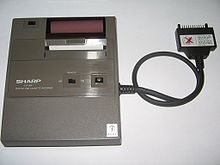This is an old revision of this page, as edited by 193.62.43.202 (talk) at 10:26, 26 March 2010. The present address (URL) is a permanent link to this revision, which may differ significantly from the current revision.
Revision as of 10:26, 26 March 2010 by 193.62.43.202 (talk)(diff) ← Previous revision | Latest revision (diff) | Newer revision → (diff)- For the type of printer which uses sparks and aluminised paper (and is sometimes referred to as a "thermal printer"), see spark printer.
| Part of a series on the | ||||||||||||||||||||||||||||||||||||||||||||||||||||||||||||||
| History of printing | ||||||||||||||||||||||||||||||||||||||||||||||||||||||||||||||
|---|---|---|---|---|---|---|---|---|---|---|---|---|---|---|---|---|---|---|---|---|---|---|---|---|---|---|---|---|---|---|---|---|---|---|---|---|---|---|---|---|---|---|---|---|---|---|---|---|---|---|---|---|---|---|---|---|---|---|---|---|---|---|
 | ||||||||||||||||||||||||||||||||||||||||||||||||||||||||||||||
Techniques
|
||||||||||||||||||||||||||||||||||||||||||||||||||||||||||||||

A thermal printer (or direct thermal printer) produces a printed image by selectively heating coated thermochromic paper, or thermal paper as it is commonly known, when the paper passes over the thermal print head. The coating turns black in the areas where it is heated, producing an image. Two-color direct thermal printers are capable of printing both black and an additional color (often red), by applying heat at two different temperatures. heya, im jordan mcwilton
Thermal transfer printing is a related method that uses a heat-sensitive ribbon instead of heat-sensitive paper.
Essential mechanisms
A thermal printer comprises these key components:
- Thermal head — generates heat; prints on paper
- Platen — a rubber roller that feeds paper
- Spring — applies pressure to the thermal head, causing it to contact the thermo-sensitive paper
- Controller boards — for controlling the mechanism
In order to print, one inserts thermo-sensitive paper between the thermal head and the platen. The printer sends an electrical current to the heating resistor of the thermal head, which in turn generates heat in a prescribed pattern. The heat activates the thermo-sensitive coloring layer of the thermo-sensitive paper, which manifests a pattern of color change in response. Such a printing mechanism is known as a thermal system or direct system.
The paper is impregnated with a solid-state mixture of a dye and a suitable matrix; a combination of a fluoran leuco dye and an octadecylphosphonic acid is an example. When the matrix is heated above its melting point, the dye reacts with the acid, shifts to its colored form, and the changed form is then conserved in metastable state when the matrix solidifies back quickly enough. See thermochromism.
Controller boards are embedded with firmware to manage the thermal printer mechanisms. The Firmware can manage multiple bar code types, graphics and logos. They enable the user to choose between different resident fonts (also including Asian fonts) and character sizes.
Controller boards can drive various sensors like paper low, paper out, door open, top of form etc., and they are available with the most commonly used interfaces, such as RS-232, parallel, USB or wireless. For point of sale application some boards can also control the cash drawer.
Applications
Thermal printers print faster and quieter than dot matrix printers. They are sometimes claimed to be more economical since their only consumable is the paper itself, but on the other hand thermal printer paper is more expensive than average paper which makes the claim dubious. There is also some question if this is true since thermal printers are a new technology and there is a developed market for dot matrix print cartridges. The printers can be rapidly refilled. Commercial applications of thermal printers include filling station pumps, information kiosks, point of sale systems, voucher printers in slot machines, and for recording live rhythm strips on hospital cardiac monitors.
Through the 1990s, many fax machines used thermal printing technology. Toward the beginning of the 21st century, however, thermal wax transfer, laser, and inkjet printing technology largely supplanted thermal printing technology in fax machines in order to allow plain-paper printouts.
The Game Boy Printer, made in 1998, was a small thermal printer used to print out certain elements from some Game Boy games.
Early formulations of the thermo-sensitive coating used in thermal paper were sensitive to incidental heat, abrasion, friction (which can cause heat, thus darkening the paper), light (which can fade printed images), and water. However, more modern thermal coating formulations have resulted in exceptional image stability; theoretically, thermally-printed text should remain legible at least 50 years.
Hospitals commonly record fetal ultrasound scan images on thermal paper. This can cause problems if the parents wish to preserve the image by laminating it using a traditional laminator, as the heat will cause the entire page to darken. It is advisable to test the laminator using thermal fax paper, or an unwanted thermal POS receipt to see if this happens. As before, an option is to make a permanent ink duplicate of the image, and laminate that, testing first to ensure that the copying process won't darken the image either.
References
- What Are Direct Thermal and Thermal Transfer RFID Printers?, RFID Radio
- http://www.zebra.com/id/zebra/na/en/index/resource_library/faqs/thermal.html
See also
- Barcode printer
- Thermal transfer printer
- Computer printer
- Daisy wheel printer
- Dot matrix printer
- Dye-sublimation printer
- Line matrix printer
- Line printer
- Inkjet printer
- Label printer
- Label printer applicator
- Laser printer